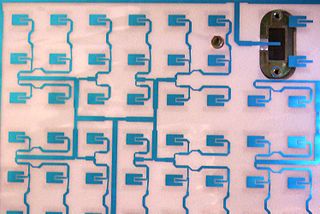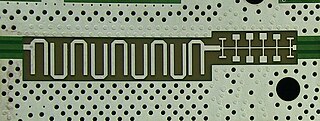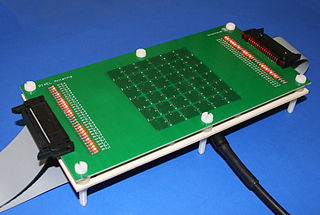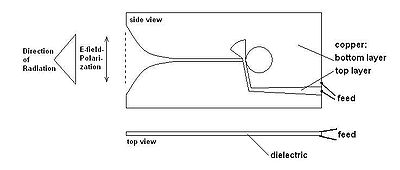
In electrical engineering, a circulator is a passive, non-reciprocal three- or four-port device that only allows a microwave or radio-frequency (RF) signal to exit through the port directly after the one it entered. Optical circulators have similar behavior. Ports are where an external waveguide or transmission line, such as a microstrip line or a coaxial cable, connects to the device. For a three-port circulator, a signal applied to port 1 only comes out of port 2; a signal applied to port 2 only comes out of port 3; a signal applied to port 3 only comes out of port 1. An ideal three-port circulator thus has the following scattering matrix:
Ultra-wideband is a radio technology that can use a very low energy level for short-range, high-bandwidth communications over a large portion of the radio spectrum. UWB has traditional applications in non-cooperative radar imaging. Most recent applications target sensor data collection, precise locating, and tracking. UWB support started to appear in high-end smartphones in 2019.

Finite-difference time-domain (FDTD) or Yee's method is a numerical analysis technique used for modeling computational electrodynamics. Since it is a time-domain method, FDTD solutions can cover a wide frequency range with a single simulation run, and treat nonlinear material properties in a natural way.

In telecommunication, a microstrip antenna usually is an antenna fabricated using photolithographic techniques on a printed circuit board (PCB). It is a kind of internal antenna. They are mostly used at microwave frequencies. An individual microstrip antenna consists of a patch of metal foil of various shapes on the surface of a PCB, with a metal foil ground plane on the other side of the board. Most microstrip antennas consist of multiple patches in a two-dimensional array. The antenna is usually connected to the transmitter or receiver through foil microstrip transmission lines. The radio frequency current is applied between the antenna and ground plane. Microstrip antennas have become very popular in recent decades due to their thin planar profile which can be incorporated into the surfaces of consumer products, aircraft and missiles; their ease of fabrication using printed circuit techniques; the ease of integrating the antenna on the same board with the rest of the circuit, and the possibility of adding active devices such as microwave integrated circuits to the antenna itself to make active antennas Patch antenna

An orthomode transducer (OMT) is a waveguide component that is commonly referred to as a polarisation duplexer. Orthomode is a contraction of orthogonal mode. Orthomode transducers serve either to combine or to separate two orthogonally polarized microwave signal paths. One of the paths forms the uplink, which is transmitted over the same waveguide as the received signal path, or downlink path. Such a device may be part of a very small aperture terminal (VSAT) antenna feed or a terrestrial microwave radio feed; for example, OMTs are often used with a feed horn to isolate orthogonal polarizations of a signal and to transfer transmit and receive signals to different ports.
A bias tee is a three-port network used for setting the DC bias point of some electronic components without disturbing other components. The bias tee is a diplexer. The low-frequency port is used to set the bias; the high-frequency port passes the radio-frequency signals but blocks the biasing levels; the combined port connects to the device, which sees both the bias and RF. It is called a tee because the 3 ports are often arranged in the shape of a T.
Characteristic modes (CM) form a set of functions which, under specific boundary conditions, diagonalizes operator relating field and induced sources. Under certain conditions, the set of the CM is unique and complete (at least theoretically) and thereby capable of describing the behavior of a studied object in full.
A dielectric resonator antenna (DRA) is a radio antenna mostly used at microwave frequencies and higher, that consists of a block of ceramic material of various shapes, the dielectric resonator, mounted on a metal surface, a ground plane. Radio waves are introduced into the inside of the resonator material from the transmitter circuit and bounce back and forth between the resonator walls, forming standing waves. The walls of the resonator are partially transparent to radio waves, allowing the radio power to radiate into space.

A substrate-integrated waveguide (SIW) is a synthetic rectangular electromagnetic waveguide formed in a dielectric substrate by densely arraying metallized posts or via holes that connect the upper and lower metal plates of the substrate. The waveguide can be easily fabricated with low-cost mass-production using through-hole techniques, where the post walls consists of via fences. SIW is known to have similar guided wave and mode characteristics to conventional rectangular waveguide with equivalent guide wavelength.

Polarization-division multiplexing (PDM) is a physical layer method for multiplexing signals carried on electromagnetic waves, allowing two channels of information to be transmitted on the same carrier frequency by using waves of two orthogonal polarization states. It is used in microwave links such as satellite television downlinks to double the bandwidth by using two orthogonally polarized feed antennas in satellite dishes. It is also used in fiber optic communication by transmitting separate left and right circularly polarized light beams through the same optical fiber.

Planar transmission lines are transmission lines with conductors, or in some cases dielectric (insulating) strips, that are flat, ribbon-shaped lines. They are used to interconnect components on printed circuits and integrated circuits working at microwave frequencies because the planar type fits in well with the manufacturing methods for these components. Transmission lines are more than simply interconnections. With simple interconnections, the propagation of the electromagnetic wave along the wire is fast enough to be considered instantaneous, and the voltages at each end of the wire can be considered identical. If the wire is longer than a large fraction of a wavelength, these assumptions are no longer true and transmission line theory must be used instead. With transmission lines, the geometry of the line is precisely controlled so that its electrical behaviour is highly predictable. At lower frequencies, these considerations are only necessary for the cables connecting different pieces of equipment, but at microwave frequencies the distance at which transmission line theory becomes necessary is measured in millimetres. Hence, transmission lines are needed within circuits.

A reconfigurable antenna is an antenna capable of modifying its frequency and radiation properties dynamically, in a controlled and reversible manner. In order to provide a dynamic response, reconfigurable antennas integrate an inner mechanism that enable the intentional redistribution of the RF currents over the antenna surface and produce reversible modifications of its properties. Reconfigurable antennas differ from smart antennas because the reconfiguration mechanism lies inside the antenna, rather than in an external beamforming network. The reconfiguration capability of reconfigurable antennas is used to maximize the antenna performance in a changing scenario or to satisfy changing operating requirements.
Debatosh Guha is an Indian researcher and educator. He is a Professor at the Institute of Radio Physics and Electronics at the Rajabazar Science College, University of Calcutta. He is an Adjunct faculty at the National Institute of Technology Jaipur and had also served Indian Institute of Technology Kharagpur as HAL Chair Professor for a period during 2015-2016.
Nuno Miguel Gonçalves Borges de Carvalho from the Universidade de Aveiro, Aveiro, Portugal was named Fellow of the Institute of Electrical and Electronics Engineers (IEEE) in 2015 for contributions on characterization and design of nonlinear RF circuits.
A defected ground structure (DGS), is a purposefully created defect on the ground plane of a printed microstrip board. It is typically created in the form of an etched-out pattern on the ground plane. DGS is a simplified form of Electromagnetic Band Gap (EBG) structure. This EBG is a periodic pattern featuring a band-stop property in microstrip transmission line and circuit applications, but the DGS comprises a single defect or a very limited number of defects with periodic/aperiodic configurations.
Yuen Tze Lo was a Chinese American electrical engineer and academician. He was a professor emeritus at the Department of Electrical and Computer Engineering at University of Illinois at Urbana–Champaign. He is best known for his contributions to the theory and design of antennas. He is the editor of the textbook series, Antenna Handbook.
David Michael Pozar is an American electrical engineer, educator and professor emeritus at the Department of Electrical and Computer Engineering at University of Massachusetts Amherst. His research interests concentrate mainly on antenna theory and design. Pozar is also the author of the textbook, Microwave Engineering.
Tapan Kumar Sarkar was an Indian-American electrical engineer and Professor Emeritus at the Department of Electrical Engineering and Computer Science at Syracuse University. He was best known for his contributions to computational electromagnetics and antenna theory.
Georges Armand Deschamps was a French American engineer and Professor Emeritus at the Department of Electrical Engineering at University of Illinois at Urbana-Champaign. He is best known for his contributions to electromagnetic theory, microwave engineering and antenna theory. He is also regarded as an early pioneer of microstrip and patch antennas, which he proposed in 1953.
Arthur Aaron Oliner was an American physicist and electrical engineer, who was professor emeritus at department of electrical and computer engineering at New York University-Polytechnic. Best known for his contributions to engineering electromagnetics and antenna theory, he is regarded as a pioneer of leaky wave theory and leaky wave antennas.









